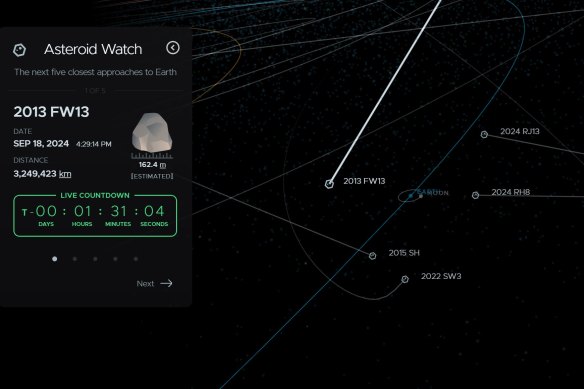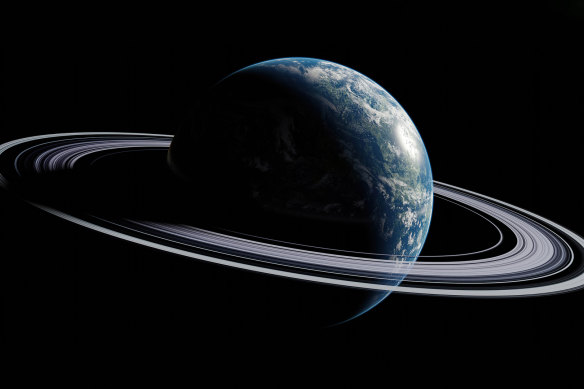By Angus Dalton
A stadium-sized asteroid and another the size of a skyscraper that rocketed by Earth in the past 24 hours have been branded potentially hazardous objects by NASA, ahead of another cosmic event next week that will see Earth gain a “second moon”.
The flurry of cosmic activity comes as Australian researchers unveil evidence gleaned from ancient craters suggesting Earth was once encircled by a Saturn-style ring.

An animation of the 35,000 known near-Earth objects. There are at least 50 asteroids larger than a kilometre and 14,000 smaller unknown asteroids still to be discovered and tracked, NASA estimates.Credit: NASA's Jet Propulsion Lab
NASA’s Jet Propulsion Lab dubs any asteroid larger than 150 metres, which is big enough to destroy a city, a “potentially hazardous object” if it passes within 7.5 million kilometres of the Earth, equivalent to about 20 times the distance between our planet and the moon.
There was no chance of a strike from the two asteroids this week, but Juan Luis Cano from the European Space Agency said the fact the stadium-sized asteroid, 2024 ON, was only discovered in July and zipped relatively close to Earth on Tuesday had important implications for ongoing research into planetary defence.
“It is small enough to only be discovered a few months before passing Earth, but large enough to cause significant damage if it had hit,” said Cano, an expert in space safety. NASA believes we’d need “many years” of warning to divert a catastrophic asteroid strike.
The second nearby asteroid, 2013 FW13, is about the size of a skyscraper and passed 3.25 million kilometres away from Earth at about 4.30pm AEST on Wednesday.

NASA’s Asteroid Watch profile for 2013 FW, a skyscraper-sized asteroid whizzing past Earth on Wednesday afternoon close enough to be dubbed a “potentially hazardous object”.Credit: NASA Jet Propulsion Laboratory
“It’s shockingly often that we discover what we call near-earth asteroids,” said Swinburne University of Technology astrophysicist Dr Sara Webb. “Every year we discover multiple, but the risk that they pose is extremely tiny.”
Another asteroid called 2024 PT5, discovered in August by the Asteroid Terrestrial-Impact Last Alert System, will swoop into Earth’s orbit on September 29 at just the right speed and angle to become a “minimoon”.
“Every now again, asteroids get gravitationally locked in orbit around the Earth for a period of time before they get flung away again,” Webb said. In 2006, Earth recruited a minimoon for almost a year and another temporarily swung into our orbit in 2020.
The 10-metre minimoon is too small to be seen with the naked eye. But the celestial visitor will make an almost-complete orbit around the Earth before it hurtles off again on November 29.

What Earth might have looked like with rings, which it may have once had from a ripped-apart minimoon.
Australian research last week revealed evidence Earth was once swathed in rings like Saturn, potentially made from the remains of a minimoon ripped apart by Earth’s gravity and its own forward velocity.
Professor Andy Tomkins, from Monash University, scrutinised a period of time 466 million years ago when Earth was blasted by meteorites, leaving behind at least 21 known craters. He identified an intriguing pattern: all the impacts were near the equator. Rings always form at a planet’s equator.
Tomkins theorised the craters were caused by asteroids plummeting from a ring of debris that formed around the Earth. The ring also may have contributed to global shading that plunged the ancient Earth into one if it’s coldest-ever Ice Ages.
Like minimoons, planetary rings are ephemeral events, Webb said. Saturn’s rings will eventually consolidate into moons.
“Jupiter, Uranus and Neptune also have very small rings associated with them,” Webb said. “It’s not surprising that at some point, other planets such as Earth would have too.”
Wednesday night will also see a supermoon, when the moon’s orbit comes closest to Earth.
The Examine newsletter explains and analyses science with a rigorous focus on the evidence. Sign up to get it each week.